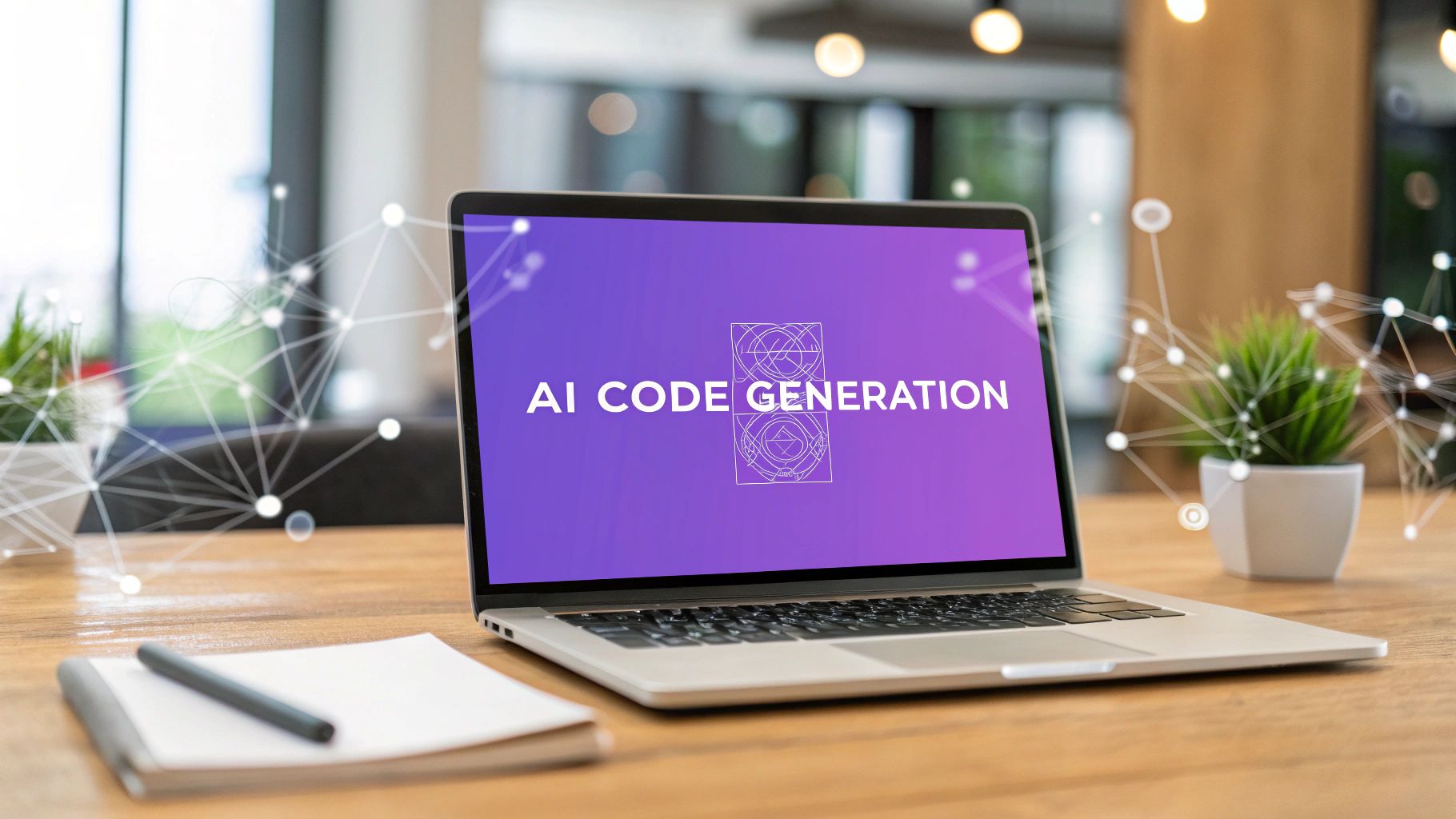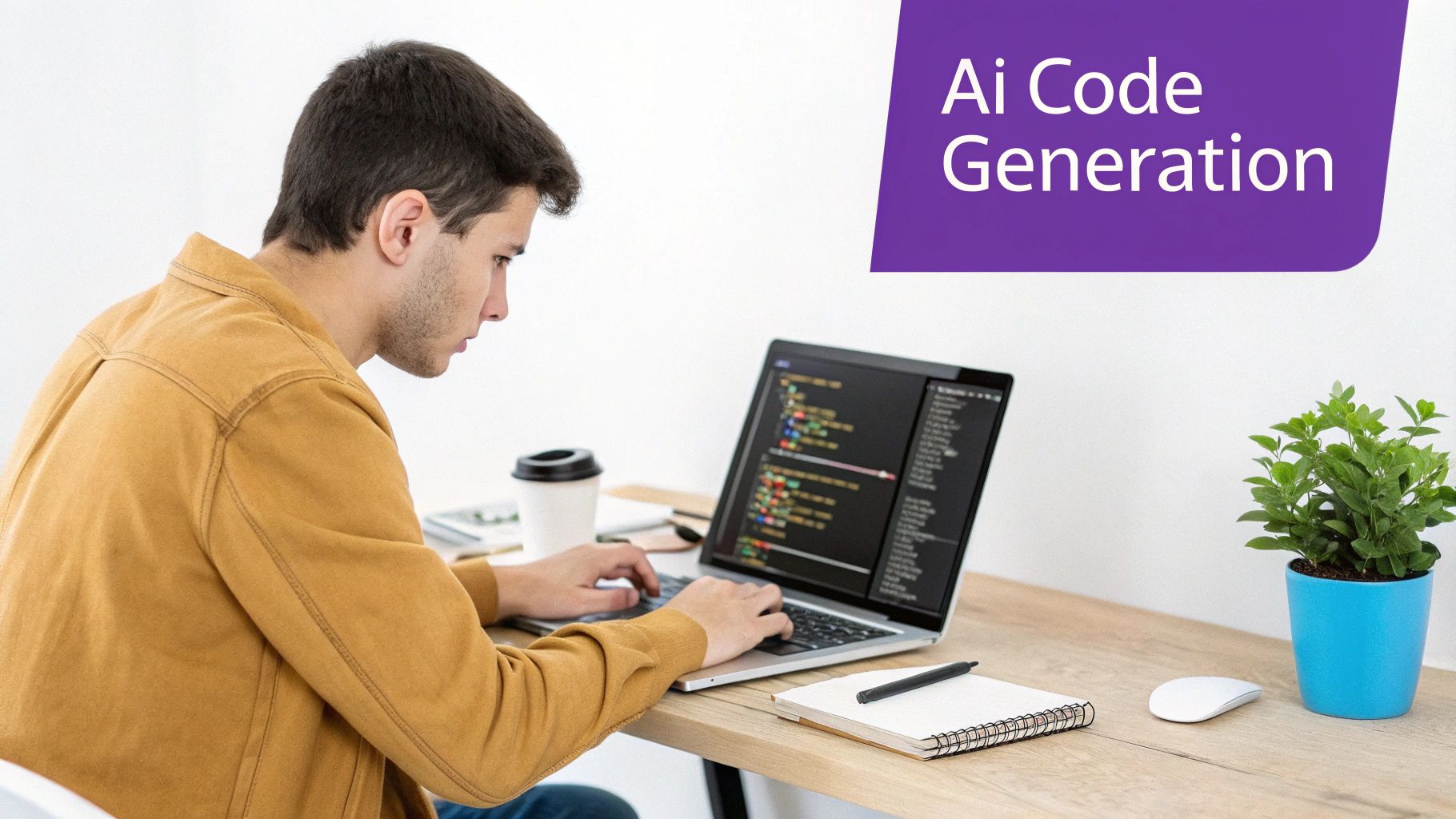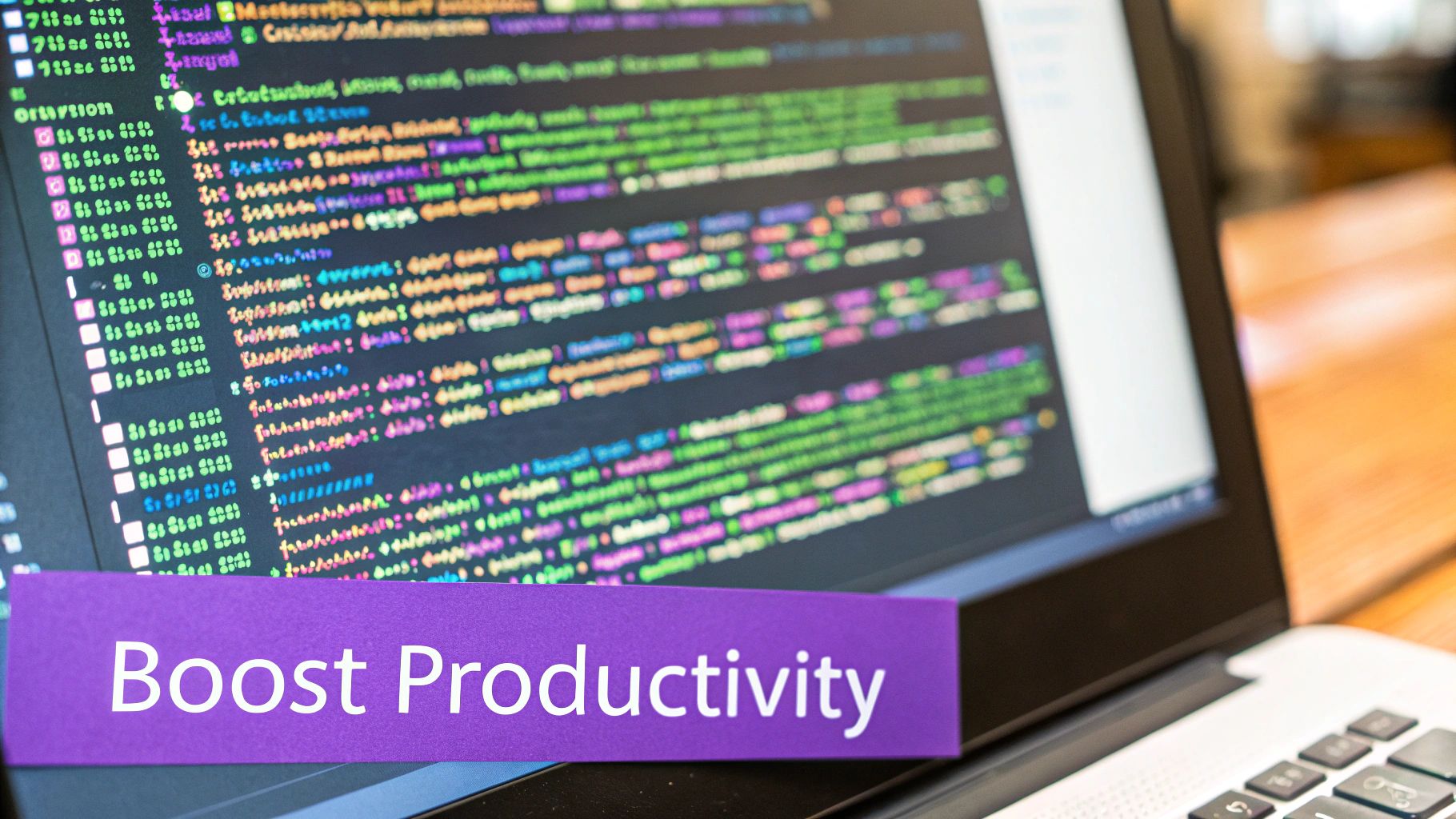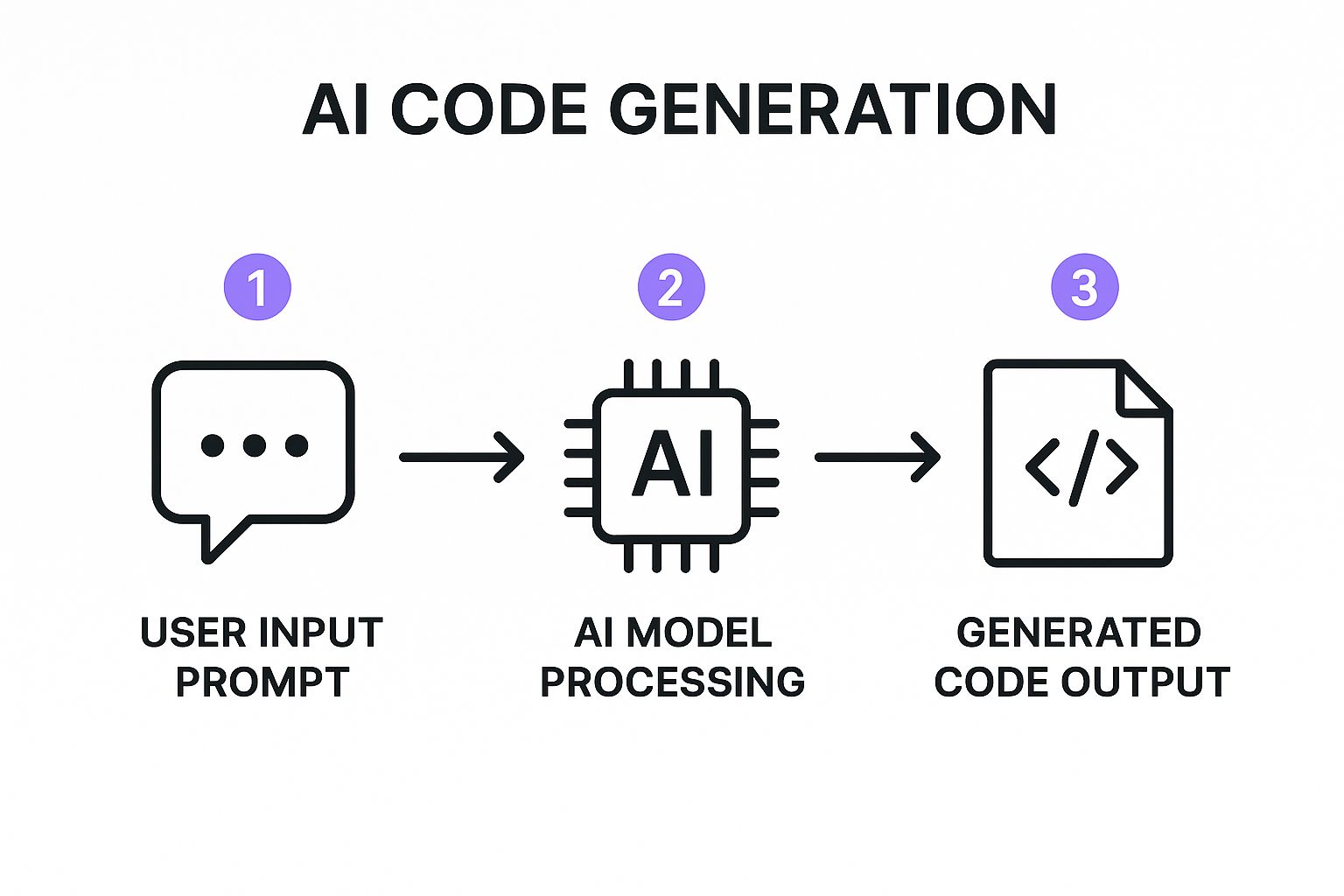AI Code Generation for Onchain Apps

AI Code Generation for Onchain Apps
Consider AI code generation as working with an exceptionally intelligent collaborator capable of swiftly translating your concepts into efficient and well-structured code. This technology does not aim to replace software developers as many folks think; instead, it significantly enhances their productivity by taking over the time-intensive tasks involved in coding.
You describe what you need in plain English, and the AI writes the code snippet, the smart contract, or sometimes even the bones of an entire application. This single shift is dramatically speeding up how fast we can build.
The New Era of Onchain Development

We've officially moved past the point where AI code generation was just a cool concept. For onchain development, it's quickly becoming an essential part of the toolkit. This isn't a small tweak; it’s a fundamental change in how we build from the ground up.
Platforms like Dreamspace, an intuitive AI app generator, are leading this charge. They give creators the power to transform a complex idea into a working smart contract or dApp with incredible speed. We're talking about generating a solid foundation in minutes, not weeks of slogging through manual code.
The Real-World Impact on Developers
This is so much more than just writing code faster. It's about completely rethinking the development workflow, and the benefits are obvious right from the start.
- Skyrocketing Productivity: Instead of getting bogged down in boilerplate, developers can stay focused on the high-level architecture and the core logic that makes their project unique.
- Fewer Annoying Bugs: AI models are trained on mountains of code, so they tend to produce clean, standardized outputs. This means fewer human errors and less time spent debugging.
- Opening the Doors to Web3: Got a brilliant idea but not a deep coding background? Now you can actually build and launch it. This is huge for democratizing who gets to create in the onchain world.
You don't have to take my word for it—the market is screaming this from the rooftops. The AI code assistant market is set to explode from USD 5.5 billion in 2024 to an estimated USD 47.3 billion by 2034. That's a staggering 24% compound annual growth rate, all because these tools genuinely make developers more efficient.
We're shifting from traditional coding to what I call "vibe coding." Your main job becomes articulating the vision, the vibe, of what you want to build. A tool like Dreamspace acts as your vibe coding studio, translating that vision directly into deployable code.
To get a feel for the tech powering this shift, it's worth understanding the capabilities of advanced AI models like those from OpenAI.
The entire process of https://blog.dreamspace.xyz/post/blockchain-application-development is becoming more idea-driven and less bogged down by syntax. Let's walk through how you can use these tools to build your own onchain apps.
Laying Out Your Project Blueprint in Dreamspace

Every great onchain app starts with a clear plan, long before a single line of code gets written. I can't stress this enough: blueprinting your project is probably the most important thing you'll do in the entire ai code generation process. It’s tempting to jump right in, but you need to think like an architect first, carefully mapping out your app's features and the logic of its smart contracts.
Working in Dreamspace feels less like programming and more like briefing a highly skilled apprentice. Your main job is to turn your vision into a set of clear, effective prompts that the AI can act on. It's a simple rule of thumb: the quality of your input directly shapes the quality of the code you get back.
From a Fuzzy Idea to a Concrete Prompt
One of the biggest mistakes I see people make is giving the AI a vague, high-level command and expecting magic. For instance, just asking for "a decentralized marketplace" is a recipe for disappointment. The AI has no clue what you want to sell, how payments will work, or what your fee structure looks like.
To get clean, secure, and genuinely useful code, you have to break your idea down into its core pieces. This is where you really use Dreamspace as a true vibe coding studio—you define the specifics, and it nails the execution.
Get specific about the core parts of your project:
- Smart Contract Logic: What are the key functions? Who gets to call them? What events do you need to emit?
- Data Structures: What information absolutely must live onchain? You need to define the exact
structsand mappings. - User Roles & Permissions: Will there be different access levels, like an admin who can do more than a regular user?
- Economic Model: How do tokens get created, sent, or destroyed? Are there fees for certain actions?
A well-structured prompt is the difference between getting a generic, insecure contract and a production-ready application. Seriously, spend 80% of your time refining the plan and only 20% on generation and tweaking.
A Real-World Example: Prompting a Token Contract
Let's look at the difference between a weak prompt and a strong one for a simple ERC-20 token.
Weak Prompt:
"Make me a crypto token."
This is way too vague. The AI will probably spit out a generic, bare-bones contract that’s not ready for any real project.
Strong, Actionable Prompt:
"Generate a secure ERC-20 token contract in Solidity. The token should be named 'Dream Token' with the symbol 'DRM'. Set a fixed total supply of 1,000,000 tokens, and make sure all of them are minted to the contract deployer's address. The contract needs to be ownable, with a function allowing only the owner to renounce ownership."
See the difference? This detailed prompt gives the AI everything it needs to know. It specifies the token standard, name, symbol, supply, how tokens are initially distributed, and a critical security feature (ownability). When you provide this level of detail upfront, you ensure the AI-generated code actually matches your project's specific needs.
Generating Your First Smart Contract
This is where the magic happens—turning your detailed blueprint into actual, living code on the blockchain. Using an AI app generator like Dreamspace, you can take a clear plan and translate it directly into a fully-functional smart contract. Let's walk through a real-world example to see just how interactive and surprisingly powerful this process is.
Imagine you want to create a standard ERC-721 NFT minting contract. Inside the Dreamspace vibe coding studio, your prompt could be as simple and direct as this:
"Generate a secure and gas-efficient ERC-721 smart contract in Solidity called 'DreamWeaver'. The token symbol should be 'DREAM'. Include a public minting function that costs 0.05 ETH per mint. Also, add an owner-only function to withdraw the contract balance."
With that clear instruction, the AI gets to work. It’s a clean flow from your plain English input, through the AI model's logic, and straight to the code output.

This really brings home a key point: the quality of your prompt is the single biggest factor in the quality of the code you get back. Garbage in, garbage out, as they say.
Breaking Down the AI's Output
What you get back isn't some indecipherable block of text. The AI-generated Solidity code will be well-structured, with functions that map directly back to what you asked for. You'll probably see a few key pieces:
- Constructor: This part sets up the basics, like the token name ('DreamWeaver') and symbol ('DREAM'), the moment the contract goes live.
safeMint()Function: This is the public-facing mint button, letting anyone mint an NFT by sending the required 0.05 ETH.withdraw()Function: A protected function, ensuring only the contract owner can pull the accumulated funds out of the contract.
The whole field of AI code generation is exploding precisely because it automates these fundamental, often repetitive tasks. It frees up developers to focus on the truly hard problems. The market for these tools was already valued at USD 6.7 billion in 2024 and is on track to hit USD 25.7 billion by 2030. That kind of growth tells you just how baked-in AI is becoming for building software efficiently.
Refining Your Smart Contract with AI
Now for the fun part—the back-and-forth. Let's say you look at the first draft and think, "I need a whitelist for a presale." You don't have to start from scratch. You just keep the conversation going.
You can follow up with another prompt, building on what's already there:
"Update the contract to include a whitelist. Add a function that only the owner can call to add addresses to the whitelist. Create a separate whitelistMint() function that is only callable by whitelisted addresses and costs 0.025 ETH."The AI will iterate on the code it just gave you, weaving in the new logic while keeping everything else intact. It's this conversational flow that makes the process so effective. You can keep tweaking things—minting fees, supply caps, permissions—until the contract is a perfect match for your vision.
For a deeper look into the nitty-gritty, our guide on how to build smart contracts offers more technical context. This iterative approach is how you can bring complex onchain logic to life without writing a single line from scratch.
Building a User-Friendly Onchain Frontend
Your smart contract can be a masterpiece of onchain logic, but without a clean, intuitive interface, it's just a high-performance engine with no steering wheel. The frontend is that crucial bridge connecting your users to the magic you've built. The good news? With modern ai code generation, you don't need to be a React guru to build it.
You can use a vibe coding studio like Dreamspace to generate the user interface (UI) components that talk directly to your contract. This whole approach frees you up to think about the user's journey, not the nitty-gritty of frontend frameworks. You describe what you want the user to do, and the AI handles the code.
Prompting Essential UI Components
Let's go back to our NFT minting contract. To actually let people use it, we need a few key pieces: a way to connect their wallet, a spot to see important info, and a button to kick off the mint. Using an AI app generator, you can create each of these elements with a specific prompt.
Here are a few prompts I’d actually use:
- For a Wallet Connection: "Generate a React component for a 'Connect Wallet' button. When clicked, it should use ethers.js to connect to a user's MetaMask wallet and display their truncated wallet address once connected."
- For Displaying Data: "Create a React component that connects to our 'DreamWeaver' smart contract and displays the total number of NFTs already minted. It should also show the current user's NFT balance."
- For Triggering an Action: "Build a simple React form with a 'Mint NFT' button. When a user clicks it, the component should call the
safeMintfunction on the smart contract, sending the required 0.05 ETH minting fee."
This piecemeal approach is surprisingly powerful. You’re essentially assembling a complete UI from a set of modular, AI-generated building blocks.
The key is to think in components. Don't ask the AI to "build the whole frontend at once." Instead, prompt for individual, self-contained pieces of the UI. This gives you cleaner code that is far easier to debug and manage.
A Practical Scenario: Building an NFT Minting UI
Alright, let's picture it. Your DreamWeaver contract is live on the network. Now you need a simple webpage where people can show up and mint their NFT.
Inside a platform like Dreamspace, which acts as a vibe coding studio, you’d start by generating the main app layout. Then, you'd prompt for the wallet connection button. Once you see that working, you'd move on. Next up, you'd ask for a component to display the minting price and the total supply.
Finally, you’d generate the minting button itself, which ties all the onchain logic together. Each prompt builds on the last, letting you construct a seamless user experience almost like a conversation.
This isn't just about moving faster; it's about making frontend development feel more intuitive. You can mock up and test user flows on the fly, making sure the final product isn't just functional but actually enjoyable to use. It’s how you close the gap between your powerful onchain code and the people who will ultimately bring it to life.
Reviewing and Deploying Your AI-Generated App

It’s tempting to treat AI code generation as a magic bullet. You type in a prompt, get your code, and ship it. But that's a massive mistake, especially when you’re building onchain where code is immutable.
Think of the AI's output as a really good first draft—something that gets you 80% of the way there, fast. The final 20% is where your expertise as a developer really shines. This is all about review, rigorous testing, and a solid deployment strategy.
Auditing for Security and Efficiency
This part of the process is less about writing fresh code and more about strategic validation. You're now wearing your auditor hat, hunting for two things: security flaws and gas inefficiencies. Even a tiny oversight in gas can add up to huge costs for your users later.
Start by just reading the smart contract. Line by line. Get familiar with it and look for the classic pitfalls—reentrancy bugs, integer overflows, unchecked external calls. An AI app generator like Dreamspace is trained on secure code, but you are the final backstop.
Once you’ve done a manual pass, bring in the automated tools to back you up.
- Static Analysis: These tools scan your code for known vulnerabilities without even running it. It's a fantastic first line of defense.
- Formal Verification: This is more intense. It’s about mathematically proving your contract logic holds up under every possible scenario.
- Gas Optimization Checks: Profile your functions to see where the gas is going. You can often refactor a few lines to make a huge difference in efficiency.
This isn't a "nice-to-have" step; it's essential. For a deeper dive, our guide on smart contract audit tools has a great list of resources to get you started.
Remember, the AI is your assistant, not the final authority. A human-led security review is the ultimate safeguard for your application and its future users. Deploying unaudited code is a risk you should never take.
The pace of innovation here is just wild. The generative AI sector is exploding, with over 8,700 patents filed globally as of 2025. And it's growing at nearly 147% every year, which just shows how quickly these tools are getting better.
The Deployment Roadmap
Okay, so your contracts have passed the audit and all your tests are green. You're almost there. Before you even think about mainnet, it’s smart to look at the bigger security picture. Getting familiar with automated AI pentesting solutions can give your onchain app another critical layer of defense.
This is where a platform like Dreamspace really helps connect the dots. It brings the generation, testing, and deployment workflows all into one place. You can go from a simple prompt to a live dApp with much more confidence. It's an integrated process that feels more like a vibe coding studio, making that final leap to a successful onchain launch a whole lot smoother.
A Few Questions We Get All The Time
Jumping into AI code generation for onchain development is exciting, but it definitely brings up some important questions. If you're wondering about security, what these tools can actually do, and what you need to know to get started, you're not alone. Let's tackle some of the most common questions we hear.
Is AI-Generated Smart Contract Code Secure?
This is, without a doubt, the most important question. And the honest answer is nuanced. Think of the code you get from an AI app generator like Dreamspace as a really, really good first draft. It's often built on a solid foundation of best practices, having learned from countless examples of secure code.
But you should absolutely never treat it as a final, audited product straight out of the gate. A human developer needs to put their eyes on it. Always. Before any smart contract handling real assets goes live, it demands a thorough review and a professional security audit. The AI gets you to the 90% mark incredibly fast, but that last 10% of human oversight is non-negotiable for security.
Can AI Really Handle Complex Onchain Logic?
Surprisingly, yes. AI can get pretty far with complex and unique application logic, but there’s a trick to it. The magic is all in how you frame your prompts. A single, vague request won't cut it. You have to break down what you need into clear, specific, and logical steps.
For anything truly novel or intricate, I’ve found a hybrid approach is the way to go. Use an AI app generator like Dreamspace to lay the groundwork—all the boilerplate, the standard functions, the basic architecture. Then, a developer can come in and hand-craft the really specific, custom pieces. It’s the perfect blend of AI’s speed and a human’s creative touch.
What Skills Do I Need To Use Dreamspace?
You don't need to be a Solidity wizard to start, but you do need a solid grasp of blockchain fundamentals and how applications are structured. The AI is great at handling the syntax of the code, but you're the one who has to provide the logic and the vision.
This is what makes a tool like Dreamspace, as a vibe coding studio, so powerful for different people.
- For seasoned devs: It's a massive workflow accelerator. You can blast through repetitive tasks and prototype new ideas at a speed that feels like a superpower.
- For product managers or founders: It’s a game-changer for building and testing functional prototypes without needing to hire a full dev team right from the start.
At the end of the day, using a platform like Dreamspace is less about manually typing code and more about clearly articulating what you want to build. You shift from being a coder to an architect, designing the system and guiding the AI to execute your vision. This is what "vibe coding" is all about.
Ready to bring your onchain ideas to life? Start building with Dreamspace, the ultimate vibe coding studio for crypto. You can generate your first smart contract and dApp in just a few minutes. Get started for free at Dreamspace.